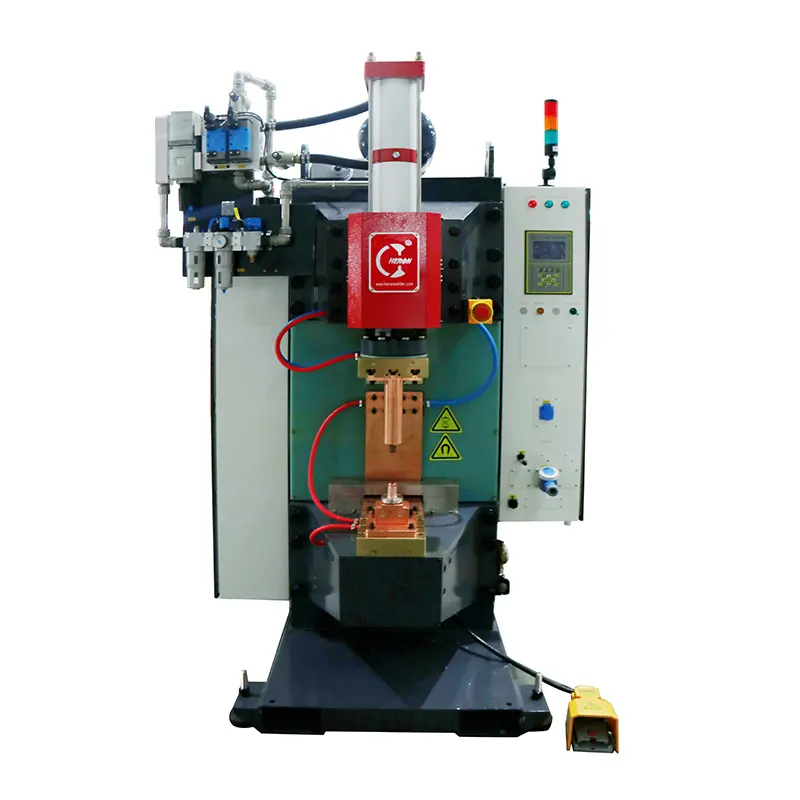Precautions and welding methods for using resistance spot welding machine
Spot welding is a resistance welding method in which the weldment is assembled and pressed between two electrodes, using resistance heat to melt the base metal to form a solder joint. Spot welding is mostly used for joining thin plates, such as aircraft skins and aviation engines. The fire chimney, car cab shell, etc. The secondary of the spot welder welding transformer only needs one loop.
The upper and lower electrodes and electrode arms are used to conduct both welding current and power. The cooling path passes through the transformer, electrodes and other parts to avoid heating. When welding, the cooling water should be passed through first and then the power switch. The quality of the electrodes is directly Affects the welding process, welding quality and consumption rate. Below, the editor will take a look at the precautions for using the resistance spot welding machine and the welding methods.
Precautions for using resistance spot welding machine:
1. Electrode materials are commonly made of copper, cadmium bronze, chromium bronze, etc. The shapes of electrodes are various and are mainly determined according to the shape of the weldment. When installing the electrodes, pay attention to keeping the upper and lower electrode surfaces parallel; the three-dimensional electrodes should be kept clean. , commonly used for trimming with emery cloth or files. Welding cycle The welding cycle of spot welding and projection welding consists of four basic stages (spot welding process).
2. Preloading stage - the electrode drops to the current connection stage to ensure that the electrode presses the workpiece so that there is appropriate pressure between the workpieces. Welding time - the welding current passes through the workpiece and heat is generated to form a nugget.
3. Maintenance time - cut off the welding current, and maintain the electrode pressure until the nugget condenses to sufficient strength. Rest time - the electrode starts to lift until the electrode starts to fall again, and the next welding cycle starts.
In order to improve the performance of welded joints, it is sometimes necessary to add one or more of the following items to the basic cycle: increase the preload to eliminate the gaps between thick workpieces and make them closely fit. Use preheating pulses to increase the strength of the metal. Plasticity makes it easy for the workpiece to fit tightly and avoid spatter; during projection welding, this can make multiple bumps evenly contact the flat plate before power welding to ensure uniform heating of each point.
Resistance spot welding machine welding method:
1. Spot welding
Spot welding is a resistance welding method that assembles welding parts into lap joints and presses them between two columnar electrodes, using resistance heat to melt the base metal to form solder joints. Spot welding is mainly used for thin plate welding. Spot welding process process:
(1) Preload to ensure good contact between workpieces.
(2) Energize to form a nugget and plastic ring at the weld.
(3) Forging with power off allows the molten nugget to cool and crystallize under the continued pressure, forming a solder joint with a dense structure and no shrinkage cavities or cracks.
2.Seam welding
(1) The process of seam welding is similar to spot welding, except that a rotating disc-shaped roller electrode is used instead of a cylindrical electrode. The weldment is assembled into a lap or butt joint and placed between the two roller electrodes. The roller pressurizes the weldment. It is a resistance welding method that rotates and delivers power continuously or intermittently to form a continuous weld.
(2) Seam welding is mainly used for welding structures where the welds are relatively regular and require sealing. The plate thickness is generally less than 3mm.
3. Butt welding
Butt welding is a resistance welding method that welds the parts along the entire contact surface.
4. Projection welding
Projection welding is to pre-process one or more protruding points on the bonding surface of a workpiece, bring them into contact with the surface of another workpiece and energize and heat them, and then collapse them to form solder joints. Resistance welding method. Projection welding is a deformation of spot welding, mainly used for welding stamping parts of low carbon steel and low alloy steel. The most suitable thickness for projection welding of plate parts is 0.54mm, and spot welding is suitable when it is less than 0.25mm. With the development of the automobile industry, high-productivity projection welding has been widely used in the manufacturing of automobile parts. Projection welding has also been widely used in the connection of wires, pipes, etc.)
Contact Person: Christina Liu
Tel: 86 20 87813325 / 86 20 87819588 / 86 20 87815075
Fax: 86 20 87813346
Address: No.63 Xin Yi Road, Guangzhou, Guangdong China 510990













